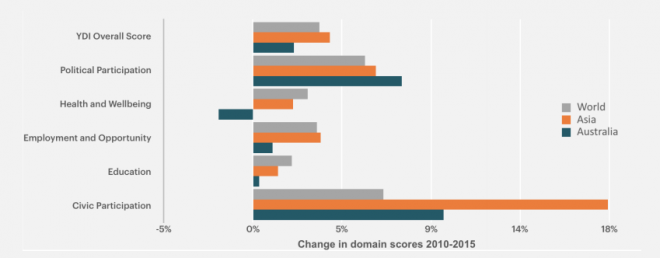The Health And Well-being Of Young Australians Has Massively Deteriorated Over The Past Decade
Drug use and STI rates are through the roof.

A group of researchers have measured the quality of life of young Australians and turned the data into the country’s first “Youth Development Index”. The Index tracks the levels of education, health and well-being, employment and opportunity, political participation and civic participation for Australians aged 15-29. It’s an initiative of the Commonwealth Youth Programme (turns out the Queen is actually responsible for something other than maintaining the pedigree of her corgis) and some of the findings are pretty brutal.
The Index found that on most measures the welfare and livelihood of young Australians had increased markedly since 2006, but on the crucial metric of health and well-being things have gotten pretty dire. Illicit drug use has nearly doubled over the past five years, with the biggest increases recorded in Tasmania and the Northern Territory. Sexually transmitted infections have also become much more prevalent with chlamydia rates increasing by a massive 60 percent over the past decade.
The report’s authors argue that while the STI statistics are quite worrying, we shouldn’t panic too much. “As improvements in awareness and utilisation of health services improves, reporting rates increase. The more you screen, the more you detect,” they wrote. “This improvement in data quality provides rates that appear to be a deterioration over time, but should be noted as a positive, as only with getting a clearer picture can individuals, state and territory governments and health practitioners deal with these issues adequately.”
Additional research from the University of New South Wales has shown that rates of gonorrhoea and syphilis infections amongst young Australians have also increased in recent years. Health experts have argued that declining condom use is a key factor leading to a rise in STI rates.
The Youth Development Index has found “stark divisions in education and employment opportunities between youth living in rural and urban areas.” The report also found that young people in the NT had the worst outcomes across the board. The issue of high youth Indigenous incarceration rates in the NT has emerged as a significant point of political tension, following an ABC investigation in allegations of torture in youth detention centres.
The good news is that employment opportunities, political participation and civic participation were all up. In particular, the proportion of young people engaging in cultural and political events had significantly increased. The report aligns with Junkee’s own research which found an increase in young people feeling passionately about social equality and rights in recent years.
So in summary, we’re more politically active but our health, especially our sexual health, is deteriorating. The good news is that practising safe sex is something within our control, though the report’s authors think what we need is “research… and publicity to inform and perhaps even shock young people into understanding the consequences of their behaviour.” A 60 percent increase in chlamydia infection rates is pretty shocking, so check out the resources below, spread the word and maybe we can fix our scores for the next Youth Development Index!
–
YEAH’s resource kit on safe-sex
Department of Health fact sheet on condom use and safe-sex
